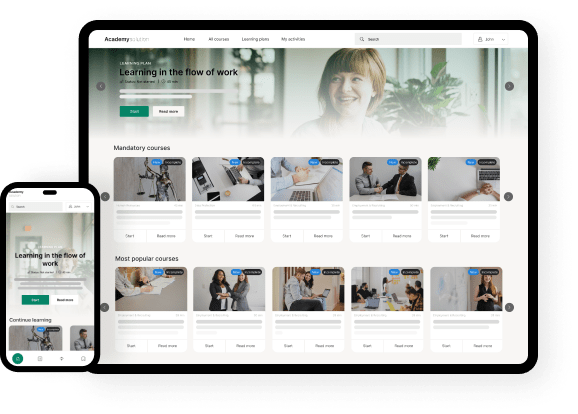When the majority of businesses are now embracing digital transformation as their new business model, does that mean you should too?
Deciding to digitize your existing value chain often doesn’t come without reservation. But worry no more! Read this blog post to understand exactly how digital transformation works. Hopefully, you’ll feel more empowered to change your business model.
What is digital transformation?

Source: The Enterprisers Project
Embracing digital transformation might appear difficult at first, but good planning and a strong strategy will make your transition smooth.
A simple way to approach digital transformation is to start putting people first before technology. That is because the creative aspect of innovation relies on people. For technology to serve its purpose, your employees must have the right expertise and knowledge to put everything into realization. We’re talking about investing in people development or learning academies.
Another approach is to concentrate on soft skills rather than hard skills. Time management, networking, and creative thinking are soft skills you can always develop on. The underlying principle here is that technical competencies can be short-lived, whereas abilities that hone the intellect often have a lasting impact.
But always remember that digital transformation is a highly internal process, which requires a stringent cultural change. And the success of this cultural change depends heavily on good leadership and engaged role models.
Is digital transformation as a business model worth It?
Knowing what drives digital transformation will help you understand why such innovation in your business is essential. For you to explore the opportunities and challenges that arise when you start leveraging technology, we’ll now present you with three notable developments in today’s business landscape:
Growing customer expectations
With the pervasiveness of online information and variety of channel choices, customers have become the primary force behind digital transformation. The demand for digital products and services continues to evolve in correspondence with customers’ expectations.
In fact, research from 2017 by Microsoft revealed that around 54 % of worldwide customers had higher expectations than they had the year before. This picture has without a doubt not changed. So, investing in quality customer service is something you by all means shouldn’t ignore in 2021.
But what does excellent customer service in this digital age mean? It may involve:

Higher expectations from your customers mean higher standards for you to live up to – and remember, your customers will compare you to your competitors.
Booming social networking
Considering the fact that 3.5 billion people are on social media, it’s no wonder why 73 % of marketers agree that social media marketing is a very effective business strategy. Pair these numbers with influencers’ impact, and you get a ton of competitive advantage. As an example, just think about Michelle Obama and the impact she made on the fashion industry during her husband’s presidency. In total, she had 189 public appearances, and the impact of her outfit choices has been calculated to 2 % per day in stock valuations of clothing companies that she represented in this period.
If you’re a growing company still hesitant to move towards digital transformation, the above facts might change your mind. Since social media is quickly becoming the primary means for communication and collaboration, it’s more important than ever for companies to create quality digital content. And we reckon, there’s no better way to deliver information than using digital platforms.
Rising popularity of enterprise mobility
Enterprise or business mobility allows remote work and the usage of laptops and mobile devices. This business model uses cloud technology to enable employees to work anytime and anywhere. It’s simply a shift from the traditional office-based setup to a remote location.
Nowadays, companies choose business mobility because it promotes flexibility and efficiency. It also has other benefits like increased productivity and decreased expenses. However, adopting business mobility requires redesigning work structures, redefining job responsibilities, and fostering a tech-friendly culture.
In 2020, mobile workers accounted for nearly 75 % of the total U.S. workforce. And the global enterprise mobility market is expected to be worth as much as $1225.78 billion in the next six years.
Looking at these facts, the more irresistible it becomes to not digitally transform your enterprise. Shravanthi Reddy, director of Product and Solutions Marketing, describes mobility as the “enabler” and the “face” of digital transformation.
Digital transformation is business innovation
Before, companies viewed digital technology in terms of how it benefitted their business. Now that factors such as customer expectations, social networks, and mobility come into play, digital transformation is no longer a part of a bigger business scheme. It is the entire business model.
Digital transformation is not just a choice. It’s a fundamental and innovative business philosophy that must be integrated into every aspect of your organization.
Regarding changes and developments in the digital age, always expect the next thing to be even bigger than what was before – figuratively and literally speaking. You must keep your business agile so it’s always ready to adapt. As Tim O’Reilly, CEO of O’Reilly Media, once said:
Every industry and every organization will have to transform itself in the next few years. What is coming at us is bigger than the original internet and you need to understand it, get on board with it and figure out how to transform your business.
Tim O’Reilly, CEO of O’Reilly Media
Take the big step with Cursum
Through digital technology, various companies are now reshaping operating models and optimizing their value chain elements.
Tesco, the third-largest retailer globally, uses digital technology in anything from self-service checkouts to “Tesco in a box” IT packages. Tesco in a box facilitates setting up new stores anywhere in the world.
Another example is the British luxury fashion house Burberry, which has an online channel specifically designed for its young customers. The channel has over 1 million followers on Facebook. It serves as a pacesetter in streaming fashion shows as well as a platform for customers’ online shopping.
While paths to digital transformation may vary by industry (and even companies), there’s no arguing that such change promotes better collaboration, more personalized ways to engage with customers, and higher staff productivity.
If your business is ready to digitally transform your organization, Cursum is ready to guide you through the process. Learn more about our services and discover how we can help you transform your business ideas into an intelligent and robust solution.


